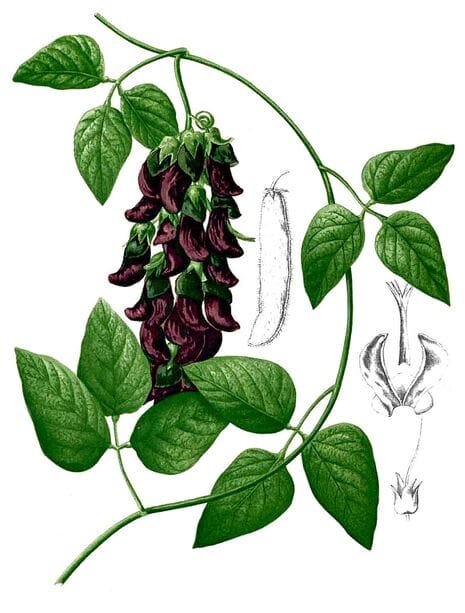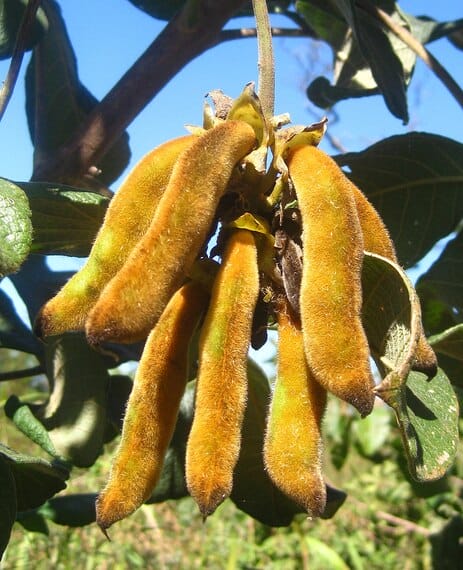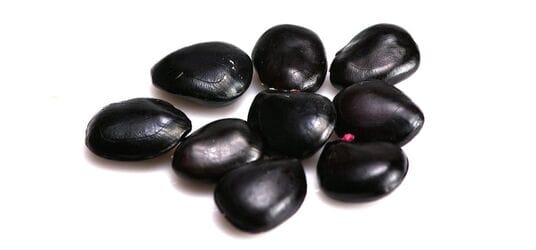Mucuna, Cowhage, Kapikachhu
CowhageKapikachhu, Atmagupta, Kavach (Ayurveda)
Kaunch (Hindi)
Konch, Habul-Kulai (Unani)
Mkhal ma zho sha མཁལ་མ་ཞོ་ཤ (Tibetan)
Li Dou, Gou Zheng Dou, Bai Li Dou (TCM)
 Mucuna pruriens
Mucuna pruriensFlora de Filipinas, Blanco, 1880
 Mucuna pruriens seed pods
Mucuna pruriens seed pods(Photo by Ton Rulkens) (Wikimedia)
 Mucuna seed
Mucuna seed(Photo by One World Thailand) (Wikimedia)
Botanical name:
Mucuna pruriens (syn. M. prurita, Dolichos pruriens)
Parts used:
Seed
Temperature & Taste:
Cool (slightly Warm in TCM), dry. Sweet, Bitter
Classifications:
3J. INCREASE SEMEN
Uses:
1. Regulates Qi, Stops Wind (Ayurveda):
-Paralysis, Facial Paralysis, Hemiplegia
-Tremors, Spasms, Parkinsonism
-Depression, Depressive Neurosis, Insanity
-Hypertension
2. Strengthens Kidneys, Nourishes Sperm (Ayurveda, Tibetan Medicine):
-increases Sperm (taken with milk and honey)
-Impotence, low Libido, Sexual Debility, Premature Ejaculation
-Infertility; benefits Fertility in men and women
-In Tibetan Medicine it is used for Hot and Cold disorders of the Kidneys; clears Kidney heat while warming Kidney Yang.
-Lumbar pain (TCM)
3. Warms the Stomach, Moves Qi (TCM)
-Colic, Intestinal spasm and pain
-stimulates peristalsis in constipation
4. Resists Poison:
-Elephantiasis, Leprosy, Eczema, Ringworm, Herpes, Syphilis
-Snake Bite, Stings, Venomous Bites
5. Externally:
i. seed powder is said to absorb Scorpion poison when applied to the bite
Dose:
As a restorative and tonic, it is taken with milk and honey or ghee.
Powder: 2–6 grams (up to 10 grams has been given)
Decoction: 3–9 grams, up to 15 grams daily.
Tincture (1:4 in 25% alcohol): 3–15 mls.
Correctives:
1. Mastic; Mastic oil; Gum Arabic (Unani)
2. Ginger, Long Pepper (to relieve their windiness)
Substitutes:
1. Asparagus adscendens,
2. Canavalia gladiata and Mucuna are regarded as being similar and can be used for one another (Tibetan)
Preparation:
Various methods have been used to process the seed: One Traditional Indian method: ‘Take of Mucuna seeds 32 tolas, boil them in 4 seers of cow’s milk till the latter becomes thick. The seeds should now be decorticated and pounded, fried in ghee (clarified butter), and made into a confection with double their weight of sugar. The mass should then be divided into balls and steeped in honey. Dose about a tola (180 grains.).’ Powerfully aphrodisiac.
Main Combinations:
Mucuna and Tribulus:
When used for its l-dopa effects, it is often taken with Tribulus seed. Tribulus contains MAO-inhibitors that suppress the breakdown caused by MAO in the mucus membrane of the intestines.
Mucuna & Chlorophytum
These are often combined in Aphrodisiac formulas in India.
1. Strengthen Fertility, Infertility:
i. Mucuna with Withania, Asparagus racemosa, Asparagus adcendens, Tribulus seed, Frankincense
ii. in women, Mucuna with Tribulus, Rose, Withania, Asparagus root (Ayurveda)
iii. in men, Mucuna with Withania with Shilajit, Zinc Bhasma
iv. Mucuna with Lotus Seed, Withania, Asparagus root (Ayurveda)
2. Male reproductive tonic, Impotence, Aphrodisiac:
i. Mucuna with Tribulus (equal parts), taken with Sugar and warm Milk; this is used as an aphrodisiac (Sushruta)
ii. Mucuna with Tribulus with Withania, Black Sesame seed, Frankincense (Ayurveda)
iii. Mucuna with Withania, Tribulus (this is researched and proven effective)
iv. Mucuna with Withania, Asparagus racemosua, Curculigo
v. Mucuna with Chlorophytum, Eulophia campestris
vi. Mucuna with Chlorophytum, Emblic Myrobalan, Salmalia root
vii. Mucuna with Chlorophytum, Basil seed, Tribulus
viii. Mucuna with Argyreia root, Withania, Leptadenia, Pyrethrum root
ix. Mucuna with Tinospora with Sida cordifolia, Sesame seed, Asparagus racemosa, Emblic Myrobalan (Ashtanga Hridaya)
3. Female Sexual Debility:
i. Mucuna with Tribulus with Curculigo, Tinospora
ii. Mucuna with Chlorophytum with Poppy seed, Asparagus root, Mastic (Ayurveda)
4. Spermatorrhea, Mucuna, Tribulus, Asparagus adscendens, Emblic Myrobalan
5. Premature Ejaculation, Mucuna with Tribulus, Asparagus racemosa, Sida rhombifolia
6. Wind disorders, Mucuna, Withania, Emblic Myrobalan, Centella/Bacopa, Indian Spikenard
7. Depression, Mucuna with Withania, Indian Spikenard
8. Spasms:
i. Mucuna with Centella
ii. Mucuna with Centella, Bacopa, Indian Spikenard, Valerian, Tribulus
9. Parkinsonism, Parkinsons’ Disease:
i. Mucuna with Bacopa
ii. Mucuna with Tribulus
iii. Mucuna with Withania, Henbane seed, Sida cordifolia
10. Lumbago, decoct Mucuna with Pig Kidney (TCM)
11. Bloating, colic and intestinal spasm, Mucuna with Fennel, Ginger, Plumbago
Major Formulas:
Musali Churna (Curculigo Powder)
Aloeswood 17 (A gar bcu bdun)
Cautions:
1. Caution in Damp and congestion.
2. Not used in acute conditions.
Drug Interactions:
1. Enhances effect of levodopa.
Main Preparations used:
|
‘The plant has long been used medicinally by the Hindus; according to Susruta the seeds are aphrodisiac. The Bhava-prakasa gives the following directions for their administration :— “Take of Mucuna seeds 32 tolas, boil them in 4 seers of cow’s milk till the latter becomes thick. The seeds should now be decorticated and pounded, fried in ghee (clarified butter), and made into a confection with double their weight of sugar. The mass should then be divided into balls and steeped in honey. Dose about a tola (180grs.). This preparat-ion is said to be powerfully aphrodisiac. (Dutt’s Hindu Materia Medica, p.148.) Similar properties are ascribed to the seeds (Hab-el-kulai) in Persian works. In the Concan a paushtik for spermatorrhoea is made by powdering the seeds of Gorf Kuhili (cultivated mucuna) and Tribulus terrestris, the roots of Eriodendron anfractuosum and Asparagus adscendens, emblic myrobalans, Tinospora starch and sugar-candy in equal proportions; of this powder 6 massa with 2 tolas of ghee are given in cow’s milk twice a day. |
The root is considered a nervine tonic, and is prescribed in paralysis. The Sanskrit names of the plant are Atmagupta, Kapikachhu, and Viiuari. According to Ainslie, a strong infusion of the root, sweetened with honey, is given by the Tamil doctors in cholera. The use of the hairs of the Mucuna pod as a vermifuge to expel ascarides appears to have originated in the West Indies, no mention of such an employment of them being found in native Indian works. They were introduced to the notice of English physicians by Bancroft about 1769, and were probably first used in India upon their admission into the Edinburgh and London Pharmacopoeias (1783-1809). They are now official in the Indian Pharmacopoeia, but are hardly ever prescribed in this country. Still there is a considerable demand for the article in the Bombay market for exportation to Europe, and it is supposed to be required for the preparation of some patent vermifuge’. (Vegetable Materia Medica of Western India, Dymock, 1885) |
